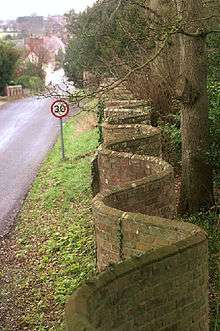Crinkle crankle wall

A crinkle crankle wall, also known as a crinkum crankum, serpentine, ribbon or wavy wall, is an unusual type of garden wall.
The crinkle crankle wall economizes on bricks, despite its sinuous configuration, because it can be made just one brick thin. If a wall this thin were to be made in a straight line, without buttresses, it would easily topple over. The alternate convex and concave curves in the wall provide stability and help it to resist lateral forces.
Both crinkle and crankle are defined as something with bends and turns (Webster's), but the term is also thought to come from Old English meaning zig-zag. The earliest reference to this meaning has been cited in 1598, but it was not until the 18th century that the term began to be applied to wavy walls. At that time these garden walls were usually aligned east-west, so that one side faced south (Dictionary of Architecture and Landscape Architecture by James Stevens Curl) to catch the warming sun and were historically used for growing fruit.[1]
Many crinkle crankle walls are found in the East Anglia area of England where the marshes of the fen country were drained by Dutch engineers starting in the mid-1600s. The walls' construction is attributed to these engineers who called them slange muur, meaning snaking wall.[2] The county of Suffolk claims at least 50 examples, twice as many as in the whole of the rest of the country, and where crinkle crankle is said to derive from a local dialect. In the estate village of Easton[3] the noted crinkle crankle wall running from the former manor house to All Saints Church is supposed to be the longest existing example. In November 2013 a section of the Easton wall suffered serious damage when a motorist crashed into the wall. An estimated £20,000 worth of damage was caused; the motorist left the scene and has yet to be identified.[4] In Lymington, Hampshire, there are a least two examples of crinkle crankle walls. The oldest is thought to have been constructed at the time of the Napoleonic Wars (1803–1815) by exiled Hanoverian soldiers living in the adjacent house.[5]
Thomas Jefferson (1743–1826) incorporated so-called serpentine walls into the architecture of the University of Virginia, which he founded. Flanking both sides of its landmark rotunda and extending down the length of the lawn are 10 pavilions, each with its own walled garden separated by crinkle crankle walls. Although some authorities claim Jefferson invented this design, he was merely adapting a well-established English style of construction. A university document in his own hand shows how he calculated the savings and combined aesthetics with utility.[6]
References
| Wikimedia Commons has media related to Serpentine walls. |
- ↑ "Glossary – Terms: crinkle-crankle wall". Park & Gardens UK. Parks and Gardens Data Services Ltd. Retrieved 24 March 2012.
- ↑ Cambridgeshire County Council (3 November 2011). "Bricklaying apprentices lay a Crinkle-Crankle wall". ShapeYourPlace.org. Retrieved 24 March 2012.
- ↑ Trevor James (1 October 2009). "Out and about looking at Crinkle Crankle Walls". The Historic Association. Retrieved 24 March 2012.
- ↑ "Easton crinkle-crackle wall damage a 'real loss'".
- ↑ "A walk about Lymington". 5 March 2012. Retrieved 24 March 2012.
- ↑ "Jefferson's serpentine walls".
- Dictionary of Architecture and Landscape Architecture by James Stevens Curl